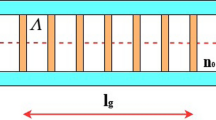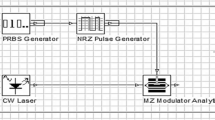Abstract
This paper presents a comprehensive study of the Gaussian Apodized Fiber Bragg Grating (GA-FBG) as a stand-alone dispersion compensator for a 150 km long optical link. The main objective of this study is to investigate the performance of GA-FBG in various compensation modes and determine the maximum transmission distance it can support as a solo dispersion compensation unit. To achieve a more cost-effective optical link, we use the GA-FBG implementation as a substitute for the expensive Dispersion-Compensating Fiber in the network. To optimize the performance, the study explores three different compensation modes and analyses the grating parameters of the GA-FBG, taking into consideration all practical limitations of a fiber Bragg grating (FBG) in the design. The optimized links are assessed based on their performance characteristics using a Bit Error Rate analyzer. After optimizing the GA-FBG and the channel parameters of the link, the results demonstrate that the GA-FBG exhibits excellent dispersion compensation capabilities. The symmetrical compensation mode yields a remarkable Q-factor value, enabling transmission distances beyond 500 km with ease. Finally, to validate the functionality of the proposed system, we use the OptiSystem software. Our findings demonstrate that the GA-FBG can effectively compensate for dispersion, achieving a more cost-effective and efficient optical link with great potential for long-distance transmission.









Similar content being viewed by others
Availability of data and materials
No datasets were generated or analyzed during the current study; therefore, data sharing is not applicable to this article.
References
Senior, J.M., Jamro, M.Y.: Optical Fiber Communications: Principles and Practice. Pearson Educations, New York (2009)
Keiser, G.: Optical Fiber Communications. Wiley Online Library, Hoboken (2003)
Gul, B., Ahmad, F.: Review of FBG and DCF as dispersion management unit for long haul optical links and WDM systems. Opt. Quantum Electron. 55(6), 557 (2023)
Sharma, A., Singh, I., Bhattacharya, S., Sharma, S.: Performance comparison of DCF and FBG as dispersion compensation techniques at 100 Gbps over 120 km using SMF. In: Nanoelectronics, Circuits and Communication Systems, pp. 435–449. Springer, Singapore (2019).
Gul, B., Ahmad, F.: Multistage amplified and dispersion compensated ultra-long haul DWDM link with high OSNR. In: 2022 Fourth International Conference on Emerging Research in Electronics, Computer Science and Technology (ICERECT), pp. 1–4. IEEE.
Ashry, I., Elrashidi, A., Mahros, A., Alhaddad, M., Elleithy, K.: Investigating the performance of apodized Fiber Bragg gratings for sensing applications. In: Proceedings of the 2014 Zone 1 Conference of the American Society for Engineering Education, pp. 1–5. IEEE (2014)
Ghosh, C., Priye, V.: Dispersion compensation in a 24× 20 Gbps DWDM system by cascaded chirped FBGs. Optik 164, 335–344 (2018)
Gul, B., Ahmad, F.: Comparative performance analysis of tanh-apodized fiber Bragg grating and Gaussian-apodized fiber Bragg grating as hybrid dispersion compensation model. In: IoT and Analytics for Sensor Networks: Proceedings of ICWSNUCA 2021, pp. 71–82. Springer, Singapore
Pal, B.P., Pande, K.: Optimization of a dual-core dispersion slope compensating fiber for DWDM transmission in the 1480–1610 nm band through G.652 single-mode fibers. Opt. Commun. 201(4–6), 335–344 (2002)
Tosi, D.: Review of chirped fiber Bragg grating (CFBG) fiber-optic sensors and their applications. Sensors 18(7), 2147 (2018)
Gul, B., Ahmad, F.: Design and performance investigation of Gaussian apodized FBG as hybrid dispersion compensation module for long-haul optical link. J. Opt. Commun. (2022)
Dar, A.B., Jha, R.K.: Design and comparative performance analysis of different chirping profiles of tanh apodized fiber Bragg grating and comparison with the dispersion compensation fiber for long-haul transmission system. J. Mod. Opt. 64(6), 555–566 (2017)
Mohammed, N.A., Solaiman, M., Aly, M.H.: Design and performance evaluation of a dispersion compensation unit using several chirping functions in a tanh apodized FBG and comparison with dispersion compensation fiber. Appl. Opt. 53(29), H239–H247 (2014)
Hussein, T.F., Rizk, M.R.M., Aly, M.H.: A hybrid DCF/FBG scheme for dispersion compensation over a 300 km SMF. Opt. Quant. Electron. 51(4), 1–16 (2019)
Dar, A.B., Jha, R.K.: Chromatic dispersion compensation techniques and characterization of fiber Bragg grating for dispersion compensation. Opt. Quant. Electron. 49(3), 1–35 (2017)
Ali, A.H., Abdulwahed, S.H., Al-Ja’afari, M.A.: Investigation of the different compensation methods for single optical channel. J. Eng. Appl. Sci. 14(9), 3018–3022 (2019)
Panda, T.K., Kumar Behera, A.M., Polei, S.: Performance comparison of Fiber Bragg Grating for different grating length, apodization function and chirp function. In: 2020 International Conference on Computer Science, Engineering and Applications (ICCSEA), pp. 1–5. IEEE (2020)
Funding
The authors confirm that they did not receive any financial or non-financial support or grants during the preparation of this manuscript.
Author information
Authors and Affiliations
Contributions
All authors contributed equally to this work.
Corresponding author
Ethics declarations
Conflict of interest
The authors declare no competing financial or non-financial interests.
Consent for publication
The authors have given their consent for the publication of this manuscript.
Ethics approval and consent to participate
Not applicable.
Additional information
Publisher's Note
Springer Nature remains neutral with regard to jurisdictional claims in published maps and institutional affiliations.
Rights and permissions
Springer Nature or its licensor (e.g. a society or other partner) holds exclusive rights to this article under a publishing agreement with the author(s) or other rightsholder(s); author self-archiving of the accepted manuscript version of this article is solely governed by the terms of such publishing agreement and applicable law.
About this article
Cite this article
Gul, B., Ahmad, F. Fiber Bragg grating as a sole dispersion compensation unit for a long haul optical link. Photon Netw Commun 46, 68–77 (2023). https://doi.org/10.1007/s11107-023-01001-4
Received:
Accepted:
Published:
Issue Date:
DOI: https://doi.org/10.1007/s11107-023-01001-4




